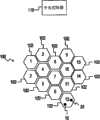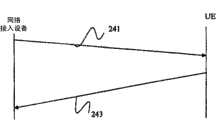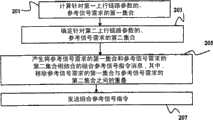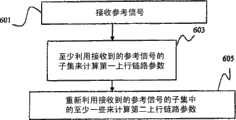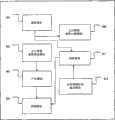CN101953213B - System and method for uplink resource utilization - Google Patents
System and method for uplink resource utilizationDownload PDFInfo
- Publication number
- CN101953213B CN101953213BCN2008801271287ACN200880127128ACN101953213BCN 101953213 BCN101953213 BCN 101953213BCN 2008801271287 ACN2008801271287 ACN 2008801271287ACN 200880127128 ACN200880127128 ACN 200880127128ACN 101953213 BCN101953213 BCN 101953213B
- Authority
- CN
- China
- Prior art keywords
- reference signal
- uplink
- network access
- access device
- requirements
- Prior art date
- Legal status (The legal status is an assumption and is not a legal conclusion. Google has not performed a legal analysis and makes no representation as to the accuracy of the status listed.)
- Expired - Fee Related
Links
Images
Classifications
- H—ELECTRICITY
- H04—ELECTRIC COMMUNICATION TECHNIQUE
- H04W—WIRELESS COMMUNICATION NETWORKS
- H04W56/00—Synchronisation arrangements
- H04W56/0005—Synchronisation arrangements synchronizing of arrival of multiple uplinks
- H—ELECTRICITY
- H04—ELECTRIC COMMUNICATION TECHNIQUE
- H04W—WIRELESS COMMUNICATION NETWORKS
- H04W52/00—Power management, e.g. Transmission Power Control [TPC] or power classes
- H04W52/02—Power saving arrangements
- H04W52/0209—Power saving arrangements in terminal devices
- H04W52/0212—Power saving arrangements in terminal devices managed by the network, e.g. network or access point is leader and terminal is follower
- H04W52/0216—Power saving arrangements in terminal devices managed by the network, e.g. network or access point is leader and terminal is follower using a pre-established activity schedule, e.g. traffic indication frame
- H—ELECTRICITY
- H04—ELECTRIC COMMUNICATION TECHNIQUE
- H04W—WIRELESS COMMUNICATION NETWORKS
- H04W72/00—Local resource management
- H04W72/20—Control channels or signalling for resource management
- H—ELECTRICITY
- H04—ELECTRIC COMMUNICATION TECHNIQUE
- H04W—WIRELESS COMMUNICATION NETWORKS
- H04W24/00—Supervisory, monitoring or testing arrangements
- H04W24/10—Scheduling measurement reports ; Arrangements for measurement reports
- H—ELECTRICITY
- H04—ELECTRIC COMMUNICATION TECHNIQUE
- H04W—WIRELESS COMMUNICATION NETWORKS
- H04W28/00—Network traffic management; Network resource management
- H04W28/16—Central resource management; Negotiation of resources or communication parameters, e.g. negotiating bandwidth or QoS [Quality of Service]
- H04W28/18—Negotiating wireless communication parameters
- Y—GENERAL TAGGING OF NEW TECHNOLOGICAL DEVELOPMENTS; GENERAL TAGGING OF CROSS-SECTIONAL TECHNOLOGIES SPANNING OVER SEVERAL SECTIONS OF THE IPC; TECHNICAL SUBJECTS COVERED BY FORMER USPC CROSS-REFERENCE ART COLLECTIONS [XRACs] AND DIGESTS
- Y02—TECHNOLOGIES OR APPLICATIONS FOR MITIGATION OR ADAPTATION AGAINST CLIMATE CHANGE
- Y02D—CLIMATE CHANGE MITIGATION TECHNOLOGIES IN INFORMATION AND COMMUNICATION TECHNOLOGIES [ICT], I.E. INFORMATION AND COMMUNICATION TECHNOLOGIES AIMING AT THE REDUCTION OF THEIR OWN ENERGY USE
- Y02D30/00—Reducing energy consumption in communication networks
- Y02D30/70—Reducing energy consumption in communication networks in wireless communication networks
Landscapes
- Engineering & Computer Science (AREA)
- Computer Networks & Wireless Communication (AREA)
- Signal Processing (AREA)
- Mobile Radio Communication Systems (AREA)
Abstract
Description
Translated fromChinese相关申请的交叉引用Cross References to Related Applications
本申请要求由蔡志军等人于12/21/2007提交的、标题为“Systemand Method for Uplink Resource Utilization”的美国临时专利申请No.61/016,195,其全部内容以引用的方式并入于此。This application claims U.S. Provisional Patent Application No. 61/016,195, filed 12/21/2007 by Zhijun Cai et al., entitled "System and Method for Uplink Resource Utilization," which is hereby incorporated by reference in its entirety.
背景技术Background technique
在传统的无线电信系统中,基站中的发送设备在已知为小区的整个地理区域中发送信号。随着技术的演进,引入了可提供先前不可能的服务的更高级网络接入设备。该高级网络接入设备可能包括例如增强node-B(eNB),而不是基站或者比传统无线电信系统中的等价设备更高度演进的其他系统和设备。这种高级的或下一代设备典型地被称作长期演进(LTE)设备。对于LTE设备,无线设备可接入电信网络的区域可能被称作除“小区”以外的名称,例如“热点”。如这里所使用的,术语“小区”将用于指代无线设备可接入电信网络的任何区域,不论该无线设备是传统蜂窝设备、是LTE设备、还是某种其他设备。In conventional wireless telecommunications systems, transmitting equipment in a base station transmits signals throughout a geographical area known as a cell. As technology has evolved, more advanced network access equipment has been introduced that can provide services that were not previously possible. This advanced network access equipment may include, for example, enhanced node-Bs (eNBs) rather than base stations or other systems and devices that are more highly evolved than equivalent equipment in traditional wireless telecommunications systems. Such advanced or next-generation equipment is typically referred to as Long Term Evolution (LTE) equipment. For LTE devices, an area where a wireless device can access a telecommunications network may be called something other than a "cell," such as a "hotspot." As used herein, the term "cell" will be used to refer to any area where a wireless device may access a telecommunications network, whether the wireless device is a traditional cellular device, an LTE device, or some other device.
用户可能在电信网络中使用的设备可以包括:移动终端,例如移动电话、个人数字助理、手持计算机、便携式计算机、膝上型计算机、写字板计算机和类似设备;以及固定终端,例如住宅网关、电视、机顶盒等等。这里,这种设备将被称作用户设备或UE。Devices that users may use in a telecommunications network may include: mobile terminals such as mobile phones, personal digital assistants, handheld computers, laptops, laptops, tablet computers and similar devices; and fixed terminals such as residential gateways, television , set-top boxes, etc. Herein, such a device will be referred to as user equipment or UE.
基于LTE设备可能提供的服务可以包括电视节目的广播或多播、成流视频、成流音频以及其他多媒体内容。这种服务常被称作多媒体广播多播服务(MBMS)。MBMS可能是贯穿单个小区或贯穿多个邻接或重叠的小区而传输的。MBMS可以是使用点对点(PTP)通信或点对多点(PTM)通信从eNB通信至UE的。Services that may be provided by LTE-based devices may include broadcast or multicast of television programs, streaming video, streaming audio, and other multimedia content. This service is often referred to as Multimedia Broadcast Multicast Service (MBMS). MBMS may be transmitted throughout a single cell or across multiple contiguous or overlapping cells. MBMS may be communicated from the eNB to the UE using point-to-point (PTP) communication or point-to-multipoint (PTM) communication.
在无线通信系统中,从无线接入设备(如eNB)至UE的传输被称作下行链路传输。从UE至网络接入设备的通信被称作上行链路传输。无线通信系统一般需要维持定时同步以允许连续的通信。维持上行链路同步可能有问题,假定UE可能不是始终有数据要发送,则浪费吞吐量和/或缩短UE的电池寿命。In a wireless communication system, transmission from a wireless access device (such as an eNB) to a UE is called downlink transmission. Communications from UEs to network access devices are called uplink transmissions. Wireless communication systems generally need to maintain timing synchronization to allow continuous communication. Maintaining uplink synchronization can be problematic given that the UE may not always have data to send, wasting throughput and/or shortening the UE's battery life.
附图说明Description of drawings
为了更完整地理解本公开,现在参照结合附图和具体实施方式而进行的以下简要描述,其中,类似的参考标记表示类似的部分。For a more complete understanding of the present disclosure, reference is now made to the following brief description taken in conjunction with the drawings and detailed description, wherein like reference numerals refer to like parts.
图1是根据本公开实施例的蜂窝网络的示意图。FIG. 1 is a schematic diagram of a cellular network according to an embodiment of the disclosure.
图2是根据本公开实施例的蜂窝网络中的小区的示意图。Fig. 2 is a schematic diagram of a cell in a cellular network according to an embodiment of the disclosure.
图3是LTE的一个可能的上行链路传输信道的示意图。Fig. 3 is a schematic diagram of a possible uplink transport channel of LTE.
图4是根据本公开实施例的定时图的示意图。4 is a schematic diagram of a timing diagram according to an embodiment of the disclosure.
图5是与网络接入设备实施例相对应的流程图。Fig. 5 is a flow chart corresponding to the embodiment of the network access device.
图6是与另一网络接入设备实施例相对应的流程图。Fig. 6 is a flowchart corresponding to another network access device embodiment.
图7是与网络接入设备实施例的另一方面相对应的流程图。Fig. 7 is a flowchart corresponding to another aspect of the network access device embodiment.
图8是与网络接入设备实施例的另一方面相对应的流程图。Fig. 8 is a flowchart corresponding to another aspect of the network access device embodiment.
图9是网络接入设备中的模块的示例图。Fig. 9 is an example diagram of modules in a network access device.
图10是包括可操作用于本公开的各个实施例中的一些的移动设备在内的无线通信系统的图。10 is a diagram of a wireless communication system including a mobile device operable for some of the various embodiments of the present disclosure.
图11是可操作用于本公开的各个实施例中的一些的移动设备的框图。Figure 11 is a block diagram of a mobile device operable for some of the various embodiments of the present disclosure.
图12是可在可操作用于本公开的各个实施例中的一些的移动设备上实现的软件环境的图。Figure 12 is a diagram of a software environment that may be implemented on a mobile device operable for some of the various embodiments of the present disclosure.
图13是根据本公开的一个实施例的示例性通用计算机。Figure 13 is an exemplary general purpose computer according to one embodiment of the present disclosure.
具体实施方式Detailed ways
应当理解,起初,尽管以下提供了本公开的一个或多个实施例的示意实施方式,但所公开的系统和/或方法可以使用任何数目的技术来实现,不论是当前已知的技术还是现有的技术。本公开决不应当限于示意实施方式、附图和以下所示的技术(包括这里示意和描述的示例设计和实施方式),而是可以在所附权利要求的范围及其等价物的全部范围内进行修改。It should be understood at the outset that although an illustrative implementation of one or more embodiments of the present disclosure is provided below, the disclosed systems and/or methods may be implemented using any number of techniques, whether currently known or existing There are technologies. The disclosure should in no way be limited to the illustrated implementations, drawings, and techniques illustrated below (including the example designs and implementations illustrated and described herein), but to be exercised within the scope of the appended claims and their full scope of equivalents Revise.
图1示意了根据本公开的实施例的示例蜂窝网络100。蜂窝网络100可以包括多个小区1021、1022、1023、1024、1025、1026、1027、1028、1029、10210、10211、10212、10213和10214(共同称作小区102)。对于本领域普通技术人员来说显而易见,小区102中的每一个表示用于通过来自网络接入设备(如eNB)的通信提供蜂窝网络100的蜂窝服务的覆盖区。尽管小区102被示作具有非重叠的覆盖区,但本领域普通技术人员应当认识到,小区102中的一个或多个可以与相邻小区具有部分重叠的覆盖。此外,尽管示出了特定数目的小区102,但本领域普通技术人员应当认识到,在蜂窝网络100中可以包括更多或更少数目的小区102。Figure 1 illustrates an example
在小区102中的每一个中可以存在一个或多个UE 10。尽管在仅一个小区10212中示出了仅一个UE 10,但对于本领域技术人员来说显而易见,在小区102中的每一个中可以存在多个UE 10。小区102中的每一个中的网络接入设备20执行与传统基站的功能类似的功能。即,网络接入设备20在电信网络中的UE 10和其他组件之间提供无线链路。尽管仅在小区10212中示出网络接入设备20,但应当理解,网络接入设备可能存在于小区102中的每一个中。此外,在蜂窝网络100中还可以存在中央控制器110,以监督小区102内的无线数据传输。In each of the
图2示出了小区10212的更详细视图。小区10212中的网络接入设备20可以经由发射机27、接收机29和/或其他公知设备来进行通信。类似的设备可能存在于其他小区102中。在小区10212中存在多个UE 10,在其他小区102中可能也是这种情况。在本公开中,将蜂窝系统或小区102描述为从事特定活动,例如发送信号;然而,对于本领域技术人员来说显而易见,这些活动实际上可能由包括小区的组件进行。Figure 2 shows a more detailed view of the cell10212 . The
在每个小区中,从网络接入设备20至UE 10的传输被称作下行链路传输,从UE 10至网络接入设备20的传输被称作上行链路传输。UE可以包括可使用蜂窝网络100进行通信的任何设备。例如,UE可以包括如下设备:蜂窝电话、膝上型计算机、导航系统或者本领域普通技术人员已知的可使用蜂窝网络100进行通信的任何其他设备。In each cell, transmissions from the
图3示意性地示出了LTE中的上行信道的格式。传输可以是多个不同带宽(如1.4、5、15或20MHz)之一。在时域中,上行链路被分为帧、子帧和时隙。时隙201由7个正交频分复用(OFDM)符号203组成。两个时隙201组成子帧205。帧是10个邻接子帧的集合。由于子帧205的精确细节可以根据LTE系统的精确实施方式而变化,因此仅作为示例提供了以下描述。子帧207的第一符号是探测(sounding)参考符号(SRS)所处的位置。UE将使用恒定幅度零自相关(CAZAC)序列来进行传输,使得多于一个UE可以同时进行传输。解调(DM)参考符号(RS)置于每个时隙209的第四符号上;控制信道211被频带的很外边缘上的至少一个资源块占用。Fig. 3 schematically shows the format of an uplink channel in LTE. The transmission can be one of several different bandwidths such as 1.4, 5, 15 or 20 MHz. In the time domain, the uplink is divided into frames, subframes and slots. A
使SRS 207在每个子帧205的开始或结束处可用,并将SRS 207分成与同资源块相同的频率带宽相对应的12个子载波的若干块。UE可以根据所选的传输带宽来使用这些频率块中的一个或全部。UE还可以在一个或多个块中使用每隔一个频率。SRS 207的传输基于单个UE的后续SRS 207传输之间的时间。图3还示出了在时间和频率上物理上行链路控制信道(PUCCH)211置于何处。控制信令发生在PUCCH 211中。在一个实施例中,系统实现混合自动重传请求(HARQ)肯定应答(ACK)/否定应答(NACK)反馈。UE在PUCCH 211上向eNB发送ACK或NACK,以指示在该UE处接收到从eNB发送的分组。物理上行链路共享信道(PUSCH)用于发送用户数据。The
上行链路信道的以上描述是针对LTE而提出的上行链路信道的一个实施方式。应当认识到,可以使用其他上行链路信道配置,其中,在上行链路消息的任何部分期间,而不必仅在指定时间间隔(如时隙)的开始或结束处,发送上行链路定时参考信号传输(如SRS)。The above description of the uplink channel is one embodiment of the uplink channel proposed for LTE. It should be appreciated that other uplink channel configurations may be used in which the uplink timing reference signal is transmitted during any part of the uplink message, not just at the beginning or end of a specified time interval (such as a time slot) Transmission (such as SRS).
为了维持上行链路同步,期望网络接入设备20(图1所示)通过分析从UE 10发送的信号来计算上行链路信道条件。除了计算上行链路信道条件以外,网络接入设备还可以确定是否需要上行链路定时中的调整。为了使网络接入设备计算上行链路信道条件,参考信号可能需要在第一持续时间接收。然而,为了使网络接入设备计算上行链路定时调整,参考信号可能需要在第二持续时间接收。结果是:存在参考信号定时需求的一个集合来计算上行链路信道条件,同时存在参考信号定时需求的第二集合来计算上行链路定时调整。In order to maintain uplink synchronization, it is desirable for the network access device 20 (shown in FIG. 1 ) to calculate uplink channel conditions by analyzing signals transmitted from the
在一个实施例中,为了最小化网络资源的使用并延长UE电池寿命,网络接入设备可以产生试图对两个需求集合进行对准的参考信号指令消息。In one embodiment, in order to minimize the use of network resources and prolong UE battery life, the network access device may generate a reference signal command message that attempts to align the two sets of requirements.
图4示出了在网络接入设备20与UE 10之间发送的信号的一种可能的定时图。在该实施例中,网络接入设备20通过使用参考信号指令消息241来指示UE 10何时发送参考信号(如SRS)。参考信号指令消息241可以包括多种指令中的任一种。例如,网络接入设备20可以经由参考信号指令消息241来指示UE 10以恒定速率或者以依赖于UE 10相对于网络接入设备20的速度的突发来发送参考信号。在响应243中,UE10可以根据网络接入设备20的指令来发送参考信号(如SRS)。FIG. 4 shows a possible timing diagram of signals sent between the
图5示意了用于在网络接入设备20中进行高效上行链路资源利用的方法的实施例。首先,在框201,网络接入设备20计算针对第一上行链路参数(例如,信道条件)的、参考信号需求的第一集合。接下来,在框203,网络接入设备确定针对第二上行链路参数(例如,上行链路定时调整)的、参考信号需求的第二集合。然后,在框205,网络接入设备20产生将参考需求的第一集合和参考信号需求的第二集合相结合的组合参考信号指令消息,其中,移除了参考信号需求的第一集合与参考信号需求的第二集合之间的重叠。然后,在框207,网络接入设备发送组合参考信号指令消息。FIG. 5 illustrates an embodiment of a method for efficient uplink resource utilization in a
在一个实施例中,当网络接入设备产生参考信号指令消息时,网络接入设备根据第一和第二需求集合来确定公共参考信号需求。然后,网络接入设备将参考信号指令消息定制为使得参考信号中的一些可以用于计算第一和第二上行链路测量参数。In an embodiment, when the network access device generates the reference signal instruction message, the network access device determines the common reference signal requirement according to the first and second requirement sets. Then, the network access device customizes the reference signal instruction message such that some of the reference signals can be used for calculating the first and second uplink measurement parameters.
例如,假设参考信号需求的第一集合需要每10毫秒(ms)发送参考信号,参考信号需求的第二集合需要每20ms发送参考信号。在没有组合参考信号指令消息的情况下,UE将每10ms发送一个参考信号,然后每20ms发送一个参考信号,导致每20ms发送两个参考信号。由于网络接入设备已经将参考信号需求的第一集合和参考信号需求的第二集合结合成组合参考信号指令消息,因此结果是:每10ms发送参考信号。因此,节约了网络资源和UE电池寿命。For example, assume that a first set of reference signal requirements requires sending reference signals every 10 milliseconds (ms), and a second set of reference signal requirements requires sending reference signals every 20 ms. In the absence of a Combined Reference Signal Command message, the UE would send a reference signal every 10ms and then send a reference signal every 20ms, resulting in two reference signals every 20ms. Since the network access device has combined the first set of reference signal requirements and the second set of reference signal requirements into a combined reference signal instruction message, the result is that the reference signal is sent every 10 ms. Thus, network resources and UE battery life are saved.
在UE处,UE接收参考信号指令消息并根据参考信号指令消息来发送参考信号。At the UE, the UE receives the reference signal instruction message and sends the reference signal according to the reference signal instruction message.
图6示意了一旦网络接入设备接收到参考信号就进行的方法的实施例。在框601,接收参考信号。在框603,网络接入设备至少利用接收到的参考信号的子集来计算第一上行链路参数。然后在框605,网络接入设备可以重新利用接收到的参考信号的子集中的至少一些来计算第二上行链路参数。Fig. 6 illustrates an embodiment of the method performed once a reference signal is received by a network access device. At
从以上继续示例,在50毫秒(ms)持续时间中,网络接入设备可以利用每10ms发送的信号中的五个来计算信道条件。然后,网络接入设备可以重新利用用于计算信道条件的信号中的两个(例如,相隔20ms的两个信号)来计算上行链路定时调整。备选地,网络接入设备可以利用每20ms发送的信号中的两个来计算上行链路定时调整。然后,网络接入设备可以重新利用这两个信号和每10ms发送的三个其他信号来计算信道条件。Continuing the example from above, for a duration of 50 milliseconds (ms), the network access device may utilize five of the signals sent every 10 ms to calculate channel conditions. The network access device may then reuse two of the signals used to calculate the channel condition (eg, two signals separated by 20 ms) to calculate the uplink timing adjustment. Alternatively, the network access device may utilize two of the signals sent every 20 ms to calculate the uplink timing adjustment. The network access device can then reuse these two signals and three other signals sent every 10ms to calculate channel conditions.
图7示意了一个实施例的方法,其中,网络接入设备产生参考信号指令消息,并且网络接入设备考虑UE是否已经请求上行链路资源分配。如果UE已经请求上行链路资源分配,则在框701,网络接入设备在时间间隔期间调度上行链路资源,并且在框703,网络接入设备还在相同时间间隔期间调度包括参考信号资源分配在内的参考信号指令消息。在框705,网络接入设备发送包括上行链路资源块和参考信号资源分配在内的消息。因此,网络接入设备指示在将使用上行链路资源块来发送数据的相同时间间隔期间要发送的参考信号。因此,当UE在其调度的上行链路资源块期间发送数据时,UE还将发送维持上行链路同步所必需的参考信号。Figure 7 illustrates a method of an embodiment wherein the network access device generates a reference signal order message and the network access device considers whether the UE has requested uplink resource allocation. If the UE has requested uplink resource allocation, then at
在一些系统中,使用非连续发送/接收(DTX/DRX)来节约UE电池寿命。在这些系统中,网络接入设备确定何时UE将醒来。因此,如图8所示,在框801,网络接入设备基于非连续接收来确定开启持续时间。然后,在框803,网络接入设备将参考信号传输调度为在UE的开启持续时间期间进行。因此,UE不必第二次醒来以发送维持上行链路同步所必需的参考信号,如果UE将要醒来以发送数据的话。In some systems, discontinuous transmission/reception (DTX/DRX) is used to save UE battery life. In these systems, the network access equipment determines when the UE will wake up. Therefore, as shown in FIG. 8, at
利用DTX和DRX的系统的示例是基于因特网协议的语音(VoIP)系统。VoIP是半永久性传输的实时数据类型。在一个实施例中,以一致的间隔(如每20ms)发送UE的VoIP分组。VoIP传输的另一特性是:语音具有话音突发和静音时段。因此,在这些系统中,有利地,维持上行链路同步或确定上行链路信道条件所必需的信号由网络接入设备调度为由UE在与上行链路数据传输相同的时间间隔期间发送。在一个实施例中,SRS是在与VoIP会话相关联的开启持续时间期间发送的。然后,SRS可以用于确定信道质量或确定是否需要定时调整。An example of a system utilizing DTX and DRX is a Voice over Internet Protocol (VoIP) system. VoIP is a real-time data type that is transmitted semi-permanently. In one embodiment, the UE's VoIP packets are sent at consistent intervals (eg, every 20 ms). Another characteristic of VoIP transmission is that speech has talk bursts and periods of silence. Thus, in these systems, advantageously, signals necessary to maintain uplink synchronization or determine uplink channel conditions are scheduled by the network access equipment to be transmitted by the UE during the same time intervals as uplink data transmissions. In one embodiment, the SRS is sent during the on-duration associated with the VoIP session. The SRS can then be used to determine channel quality or to determine if timing adjustments are required.
为了执行上述方法,网络接入设备20包括处理器。如图9所示,该处理器包括接收模块901、上行链路参数需求模块903、产生模块905、传输模块907、上行链路参数计算模块909、调度模块911和开启持续时间确定模块913。这些模块是为了简明而确定的,并可以以软件、硬件、固件或全部来执行。此外,这些模块可以存储于相同或不同的存储器中。此外,这些模块可以被组合成一个或多个模块。接收机模块901接收消息和定时信号。上行链路参数需求模块903计算针对第一上行链路参数的、参考信号需求的第一集合并确定针对第二上行链路参数的、参考信号需求的第二集合。在一个实施例中,上行链路参数模块被分成两个分离的模块,一个用于计算,一个用于确定。将上行链路参数需求模块903的输出发送至产生模块905。产生模块905产生将参考信号需求的第一集合和参考信号需求的第二集合相结合的组合参考信号指令消息。将产生模块905的输出发送至传输模块907,传输模块907发送组合参考信号指令消息。In order to execute the above method, the
在一个实施例中,接收模块901接收定时信号。然后,将定时信号发送至上行链路参数计算模块909。然后,上行链路参数计算模块909基于接收到的定时信号来计算第一上行链路参数和第二上行链路参数。在一个实施例中,上行链路参数计算模块909被分成两个模块,一个用于计算第一上行链路参数,第二个用于计算第二上行链路参数。In one embodiment, the receiving
在一个实施例中,调度模块911在时间间隔中调度上行链路资源块,并在相同时间间隔中调度参考信号资源分配。将调度模块911的输出发送至传输模块907,传输模块907发送包括上行链路资源块和参考信号资源在内的消息。In one embodiment, the
在一个实施例中,开启持续时间确定模块913基于非连续接收来确定开启持续时间。将开启持续时间确定模块913的输出发送至调度模块911,调度模块911将参考信号传输调度为在开启持续时间期间进行。In one embodiment, the on-
图10示意了包括UE 10的实施例在内的无线通信系统。UE 10可操作用于实现本公开的方面,但本公开决不应当限于这些实施方式。尽管被示为移动电话,但UE 10可以采用各种形式,包括无线手机、寻呼机、个人数字助理(PDA)、便携式计算机、写字板计算机或膝上型计算机。许多合适设备将这些功能中的一些或全部进行组合。在本公开的一些实施例中,UE 10不是如便携式、膝上型或写字板计算机之类的通用计算设备,而是如移动电话、无线手机、寻呼机、PDA或车载电信设备之类的专用通信设备。在另一实施例中,UE 10可以是便携式、膝上型或其他计算设备。UE 10可以支持专门的活动,例如游戏、库存控制、作业控制和/或任务管理功能等。FIG. 10 illustrates a wireless communication system including an embodiment of
UE 10包括显示器402。UE 10还包括供用户输入的、统称为404的触摸敏感表面、键盘或其他输入键。键盘可以是全字母数字键盘或简化字母数字键盘,例如QWERTY、Dvorak、AZERTY以及顺序类型,或者可以是与电话键区相关联的具有字母的传统数字键区。输入键可以包括滚轮、退出或换码键、轨迹球以及其他导航或功能键,其可以被向内按下以提供更多的输入功能。UE 10可以呈现供用户选择的选项、供用户驱动的控件和/或供用户导向的光标或其他指示器。
UE 10还可以接受来自用户的数据条目,该数据条目包括用于拨号的数字或用于对UE 10的操作进行配置的各种参数值。UE 10还可以响应于用户命令来执行一个或多个软件或固件应用程序。这些应用程序可以将UE 10配置为响应于用户交互来执行各种定制功能。此外,UE 10可以是无线电编程和/或配置的,例如从无线基站、无线接入点或对等端UE 10。The
在可由UE 10执行的各种应用程序当中有网页浏览器,其使显示器402能够示出网页。该网页可以经由与无线网络接入节点、蜂窝塔、对等端UE 10或者任何其他无线通信网络或系统400进行无线通信来获得。网络400耦合至有线网络408(如因特网)。经由无线链路和有线网络,UE 10可访问各种服务器(如服务器410)上的信息。服务器410可以提供可在显示器402上示出的内容。备选地,UE 10可以以中继类型或跳转类型的连接,通过充当中间点的对等端UE 10,来接入网络400。Among the various applications executable by the
图11示出了UE 10之一的框图。尽管示出了UE 10的多种已知组件,但在一个实施例中,可以在UE 10中包括所列出的组件和/或未列出的附加组件的子集。UE 10包括数字信号处理器(DSP)502和存储器504。如图所示,UE 10还可以包括天线和前端单元506、射频(RF)收发器508、模拟基带处理单元510、麦克风512、听筒扬声器514、耳机端口516、输入/输出接口518、可拆卸式存储卡520、通用串行总线(USB)端口522、短距离无线通信子系统524、报警器526、键区528、液晶显示器(LCD),该液晶显示器(LCD)可以包括触敏表面530、LCD控制器532、电荷耦合器件(CCD)摄像机534、摄像机控制器536和全球定位系统(GPS)传感器538。在一个实施例中,UE 10可以包括另一种显示器,其不提供触敏屏幕。在一个实施例中,DSP 502可以直接与存储器504进行通信而无需经过输入/输出接口518。FIG. 11 shows a block diagram of one of the
DSP 502或某其他形式的控制器或中央处理单元操作用于根据在存储器504中存储的或在DSP 502本身内包含的存储器中存储的嵌入式软件或固件,来控制UE 10的各种组件。除了嵌入式软件或固件之外,DSP 502还可以执行其他应用程序,该应用程序存储在存储器504中或可经由如便携式数据存储介质(如可拆卸式存储卡520)之类的信息载体介质,或者经由有线或无线网络通信而获取到。应用软件可以包括已编译的机器可读指令集,其将DSP 502配置为提供所期望的功能,或者应用软件可以是要由解释器或编译器处理以间接配置DSP502的高级软件指令。DSP 502 or some other form of controller or central processing unit is operative to control the various components of
可以提供天线和前端单元506以在无线信号和电信号之间进行转换,使得UE 10能够发送和接收来自蜂窝网络或某些其他可用无线通信网络或来自对等端UE 10的信息。在一个实施例中,天线和前端单元506可以包括多个天线以支持波束成形和/或多输入多输出(MIMO)操作。本领域技术人员已知,MIMO操作可以提供空间多样性,其可以用于克服困难的信道条件和/或增大信道吞吐量。天线和前端单元506可以包括天线调谐和/或阻抗匹配组件、RF功率放大器和/或低噪声放大器。An antenna and front-end unit 506 may be provided to convert between wireless and electrical signals, enabling the
RF收发器508提供了频移,将接收到的RF信号转换到基带并将基带发送信号转换到RF。在一些描述中,无线电收发器或RF收发器可以被理解为包括其他信号处理功能,如调制/解调、编码/解码、交织/去交织、扩频/解扩、快速傅立叶逆变换(IFFT)/快速傅立叶变换(FFT)、循环前缀附加/移除以及其他信号处理功能。出于清楚的目的,此处的描述将该信号处理的描述与RF和/或无线电级(radio stage)分开,并在构思上将该信号处理分配给模拟基带处理单元510和/或DSP 502或其他中央处理单元。在一些实施例中,RF收发器508、天线和前端506的部分以及模拟基带处理单元510可以被组合在一个或多个处理单元和/或特定用途集成电路(ASIC)中。The RF transceiver 508 provides frequency shifting, converting received RF signals to baseband and converting baseband transmit signals to RF. In some descriptions, a radio transceiver or RF transceiver may be understood to include other signal processing functions such as modulation/demodulation, encoding/decoding, interleaving/deinterleaving, spreading/despreading, inverse fast Fourier transform (IFFT) / Fast Fourier Transform (FFT), cyclic prefix addition/removal, and other signal processing functions. For purposes of clarity, the description herein separates the description of this signal processing from the RF and/or radio stage (radio stage), and conceptually distributes this signal processing to the analog baseband processing unit 510 and/or the DSP 502 or other central processing units. In some embodiments, RF transceiver 508, portions of antenna and front end 506, and analog baseband processing unit 510 may be combined in one or more processing units and/or application specific integrated circuits (ASICs).
模拟基带处理单元510可以提供对输入和输出的各种模拟处理,例如对来自麦克风512和耳机516的输入的模拟处理以及对向听筒514和耳机516的输出的模拟处理。为此,模拟基带处理单元510可以具有连接至内置麦克风512和听筒扬声器514的端口,使得UE 10能够用作蜂窝电话。模拟基带处理单元510还可以包括连接至耳机或其他免提麦克风和扬声器配置的端口。模拟基带处理单元510可以沿一个信号方向提供数模转换并沿相反的信号方向提供模数转换。在一些实施例中,模拟基带处理单元510的至少一些功能可以由数字处理组件来提供,例如由DSP 502或其他中央处理单元来提供。Analog baseband processing unit 510 may provide various analog processing of inputs and outputs, such as analog processing of input from microphone 512 and earphone 516 and output to earpiece 514 and earphone 516 . To this end, the analog baseband processing unit 510 may have ports connected to a built-in microphone 512 and earpiece speaker 514, enabling the
DSP 502可以执行调制/解调、编码/解码、交织/去交织、扩频/解扩、快速傅立叶逆变换(IFFT)/快速傅立叶变换(FFT)、循环前缀附加/移除以及其他与无线通信相关联的信号处理功能。在一个实施例中,例如在码分多址(CDMA)技术应用中,针对发送器功能,DSP 502可以执行调制、编码、交织和扩频,而针对接收器功能,DSP 502可以执行解扩、去交织、解码和解调。在另一实施例中,例如在正交频分多址(OFDMA)技术应用中,针对发送器功能,DSP 502可以执行调制、编码、交织、快速傅立叶逆变换和循环前缀附加,而针对接收器功能,DSP 502可以执行循环前缀移除、快速傅立叶变换、去交织、解码和解调。在其他无线技术应用中,还有其他信号处理功能和信号处理功能的组合可以由DSP 502执行。DSP 502 can perform modulation/demodulation, encoding/decoding, interleaving/deinterleaving, spreading/despreading, inverse fast Fourier transform (IFFT)/fast Fourier transform (FFT), cyclic prefix appending/removal, and other wireless communications associated signal processing functions. In one embodiment, DSP 502 may perform modulation, coding, interleaving, and spreading for transmitter functions, and for receiver functions, DSP 502 may perform despreading, To interleave, decode and demodulate. In another embodiment, such as in Orthogonal Frequency Division Multiple Access (OFDMA) technology applications, for transmitter functions, DSP 502 can perform modulation, coding, interleaving, inverse fast Fourier transform, and cyclic prefix addition, while for receiver functions function, the DSP 502 can perform cyclic prefix removal, fast Fourier transform, de-interleaving, decoding and demodulation. There are other signal processing functions and combinations of signal processing functions that can be performed by DSP 502 in other wireless technology applications.
DSP 502可以经由模拟基带处理单元510与无线网络进行通信。在一些实施例中,该通信可以提供互联网连接性,使得用户能够访问互联网上的内容并能够发送和接收电子邮件或文本消息。输入/输出接口518将DSP 502与各种存储器和接口互相连接。存储器504和可拆卸式存储卡520可以提供软件和数据以配置DSP 502的操作。在接口当中可以有USB接口522和短距离无线通信子系统524。USB接口522可以用于为UE 10充电,还可以使UE 10能够充当外围设备以与个人计算机或其他计算机系统交换信息。短距离无线通信子系统524可以包括红外端口、蓝牙接口、遵循IEEE 802.11的无线接口、或任意其他短距离无线通信子系统,其可以使UE 10能够与其他附近移动设备和/或无线基站进行无线通信。DSP 502 may communicate with a wireless network via analog baseband processing unit 510. In some embodiments, the communication may provide Internet connectivity, enabling users to access content on the Internet and to send and receive email or text messages. Input/output interface 518 interconnects DSP 502 with various memories and interfaces. Memory 504 and removable memory card 520 may provide software and data to configure the operation of DSP 502. Among the interfaces may be a USB interface 522 and a short-range wireless communication subsystem 524 . The USB interface 522 can be used to charge the
输入/输出接口518还可以将DSP 502连接至报警器526,报警器526在被触发时使UE 10通过例如振铃、播放旋律或震动来向用户提供通知。报警器526可以充当一种机制,用于通过无声震动或播放为特定呼叫者预先指定的特定旋律来向用户告警各种事件中的任一个,如输入呼叫、新文本消息和约会提醒。The input/output interface 518 may also connect the DSP 502 to an alarm 526 which, when triggered, causes the
键区528经由接口518耦合至DSP 502,以提供一种供用户进行选择、输入信息以及向UE 10提供输入的机制。键区528可以是全字母数字键盘或简化字母数字键盘(如QWERTY、Dvorak、AZERTY和顺序类型)或者与电话键区相关联的带有字母表字母的传统数字键区。输入键可以包括滚轮、退出或换码键、轨迹球和其他导航或功能键,其可以被向内按下以提供更多的输入功能。另一种输入机制可以是LCD530,其可以包括触摸屏能力,也可以向用户显示文本和/或图形。LCD控制器532将DSP 502耦合至LCD 530。Keypad 528 is coupled to DSP 502 via interface 518 to provide a mechanism for a user to make selections, enter information, and provide input to
如果配备有CCD摄像机534,则其使UE 10能够拍摄数字画面。DSP502经由摄像机控制器536与CCD摄像机534进行通信。在另一实施例中,可以采用根据与电荷耦合器件摄像机不同的技术而操作的摄像机。GPS传感器538耦合至DSP 502,以对全球定位系统信号进行解码,从而使UE 10能够确定其位置。各种其他外围设备也可以被包括进来以提供附加的功能,例如,无线电和电视接收。If equipped with a CCD camera 534, it enables the
图12示出了可由DSP 502实现的软件环境602。DSP 502执行操作系统驱动器604,操作系统驱动器604提供其余软件操作的平台。操作系统驱动器604向无线设备硬件的驱动器提供了应用软件可访问的标准化接口。操作系统驱动器604包括应用程序管理服务(“AMS”)606,该服务在运行于UE 10上的应用程序之间传送控制。图12还示出了网页浏览器应用程序608、媒体播放器应用程序610和Java小应用程序612。网页浏览器应用程序608将UE 10配置为充当网页浏览器,允许用户向表格中输入信息和选择链接以检索和查看网页。媒体播放器应用程序610将UE 10配置为检索和播放音频或视听媒体。Java小应用程序612将UE 10配置为提供游戏、实用程序和其他功能。组件614可能提供与本公开相关的功能。FIG. 12 shows a
图1的UE 10、ENB 20和中央控制器110以及可能与小区102相关联的其他组件可以包括以下任何通用计算机:其具有充足的处理能力、存储资源和网络吞吐量能力以处理置于其上的必要工作负荷。图13示出了可适于实现这里描述的一个或多个实施例的典型通用计算机系统700。计算机系统700包括处理器720(可称作中央处理单元或CPU),处理器720与包括辅助存储器750、只读存储器(ROM)740、随机存取存储器(RAM)730、输入/输出(I/O)设备710和网络连接性设备760在内的存储设备进行通信。该处理器720可以被实现为一个或多个CPU芯片。
辅助存储器750典型地包括一个或多个盘驱动器或带驱动器,并用于数据的非易失性存储,并在RAM 730不足够大以容纳所有工作数据的情况下用作溢出数据存储设备。当选择了被加载至RAM 730中的程序以执行时,辅助存储器750可以用于存储这种程序。ROM 740用于存储在程序执行期间读取的指令以及可能存储在程序执行期间读取的数据。ROM 740是非易失性存储设备,其典型地具有与辅助存储器的较大存储容量相比较小的存储容量。RAM 730用于存储易失性数据以及可能存储指令。对ROM 740和RAM 730的访问典型地比对辅助存储器750的访问要快。
I/O设备710可以包括打印机、视频监视器、液晶显示器(LCD)、触摸屏显示器、键盘、键区、开关、拨号盘、鼠标、轨迹球、语音辨认器、卡读取器、纸带读取器或其他公知输入设备。I/
网络连接性设备760可以采用以下形式:调制解调器、调制解调器组、以太网卡、通用串行总线(USB)接口卡、串行接口、令牌环卡、光纤分布式数据接口(FDDI)卡、无线局域网(WLAN)卡、无线电收发器卡(例如码分多址(CDMA)和/或全球移动通信系统(GSM)无线电收发器卡)以及其他公知网络设备。这些网络连接性760设备可以使处理器720能够与互联网或者一个或多个内联网进行通信。利用这种网络连接,可以想到,处理器720在执行上述方法步骤的过程中可能从网络接收信息或可能向网络输出信息。常被示作要使用处理器720执行的一系列指令的这种信息是可以例如以体现在载波中的计算机数据信号的形式从网络接收和输出至网络的。
可包括例如要使用处理器720执行的数据或指令在内的这种信息是可以例如以计算机数据基带信号或体现在载波中的信号的形式从网络接收和输出至网络的。由网络连接性760设备产生的基带信号或体现在载波中的信号可以在电导体表面中或电导体表面上、在同轴电缆中、在波导中、在光学介质(例如光纤)中或者在空气或自由空间中进行传播。基带信号或嵌入载波中的信号中所包含的信息可以是根据不同序列(如可能是期望处理或产生信息或者发送或接收信息)来排序的。基带信号或嵌入载波中的信号或者其他类型的当前使用或今后开发的信号(这里称作传输介质)可以是根据本领域技术人员公知的若干方法来产生的。Such information, which may include, for example, data or instructions to be executed using
处理器720执行其从硬盘、软盘、光盘(基于这些各种盘的系统都可以被视为辅助存储器750)、ROM 740、RAM 730或网络连接性设备760访问的指令、代码、计算机程序、脚本。尽管仅示出了一个处理器720,但可以存在多个处理器。因此,指令可以被讨论为由处理器执行,而该指令可以由一个或多个处理器同时、串行或以其他方式执行。
尽管在本公开中已提供了若干个实施例,但应当注意,在不脱离本公开的精神或范围的情况下,可以以许多其他具体形式来体现所公开的系统和方法。本公开的示例应被视为示意性的而非限制性的,并且并不意在限制这里给出的细节。例如,可以在另一系统中组合或结合各种元件或组件,或者可以省略或不实现特定特征。While several embodiments have been provided in the present disclosure, it should be noted that the disclosed systems and methods may be embodied in many other specific forms without departing from the spirit or scope of the present disclosure. The examples of this disclosure should be considered illustrative rather than restrictive, and limitations to the details given herein are not intended. For example, various elements or components may be combined or combined in another system, or specific features may be omitted or not implemented.
此外,在不脱离本公开的范围的情况下,在各个实施例中描述和示出为分离或单独的技术、系统、子系统和方法可以与其他系统、模块、技术或方法组合或结合。被示出或讨论为彼此耦合或直接耦合或进行通信的其他项目可以通过某种接口、设备或中间组件来(不论是电、机械还是以其他方式)间接耦合或进行通信。在不脱离这里公开的精神和范围的情况下,本领域技术人员可确定改变、替换和变更的其他示例。Furthermore, techniques, systems, subsystems and methods described and shown in various embodiments as separate or separate may be combined or combined with other systems, modules, techniques or methods without departing from the scope of the present disclosure. Other items shown or discussed as coupled or directly coupled or communicating with each other may be indirectly coupled or communicating through some interface, device, or intermediate component (whether electrical, mechanical, or otherwise). Other examples of changes, substitutions, and alterations can be ascertained by those skilled in the art without departing from the spirit and scope disclosed herein.
Claims (10)
Translated fromChineseApplications Claiming Priority (3)
| Application Number | Priority Date | Filing Date | Title |
|---|---|---|---|
| US1619507P | 2007-12-21 | 2007-12-21 | |
| US61/016,195 | 2007-12-21 | ||
| PCT/US2008/087462WO2009085973A2 (en) | 2007-12-21 | 2008-12-18 | System and method for uplink resource utilization |
Publications (2)
| Publication Number | Publication Date |
|---|---|
| CN101953213A CN101953213A (en) | 2011-01-19 |
| CN101953213Btrue CN101953213B (en) | 2013-08-21 |
Family
ID=40626676
Family Applications (1)
| Application Number | Title | Priority Date | Filing Date |
|---|---|---|---|
| CN2008801271287AExpired - Fee RelatedCN101953213B (en) | 2007-12-21 | 2008-12-18 | System and method for uplink resource utilization |
Country Status (8)
| Country | Link |
|---|---|
| US (1) | US8855032B2 (en) |
| EP (1) | EP2232936A2 (en) |
| JP (2) | JP5068377B2 (en) |
| CN (1) | CN101953213B (en) |
| BR (1) | BRPI0821762A8 (en) |
| CA (1) | CA2710389A1 (en) |
| MX (1) | MX2010006988A (en) |
| WO (1) | WO2009085973A2 (en) |
Families Citing this family (11)
| Publication number | Priority date | Publication date | Assignee | Title |
|---|---|---|---|---|
| WO2011038775A1 (en)* | 2009-10-02 | 2011-04-07 | Nokia Siemens Networks Oy | Method for delaying sending of messages from a user equipment assigned to a base station within a cell of a mobile network |
| US20110194630A1 (en)* | 2010-02-10 | 2011-08-11 | Yang Hua-Lung | Systems and methods for reporting radio link failure |
| CN102215589A (en)* | 2010-04-09 | 2011-10-12 | 电信科学技术研究院 | Method, device and system for sending SRS (Sounding Reference Symbols) |
| JP5478775B2 (en)* | 2011-04-04 | 2014-04-23 | 京セラ株式会社 | Mobile communication method, radio terminal and apparatus |
| CN102781073B (en)* | 2011-05-11 | 2016-08-03 | 中兴通讯股份有限公司 | The uplink synchronisation method received based on noncontinuity and system, base station |
| US9161371B2 (en)* | 2011-07-21 | 2015-10-13 | Qualcomm Incorporated | Power optimization using scheduling request delay |
| JP5659318B2 (en)* | 2012-04-11 | 2015-01-28 | 株式会社日立国際電気 | Wireless system, wireless base station, and management apparatus |
| US20150009874A1 (en)* | 2013-07-08 | 2015-01-08 | Amazon Technologies, Inc. | Techniques for optimizing propagation of multiple types of data |
| CN109547174B (en)* | 2017-08-10 | 2022-05-24 | 华为技术有限公司 | Time configuration method, network equipment and UE |
| WO2019157663A1 (en)* | 2018-02-13 | 2019-08-22 | 富士通株式会社 | Method and device for indicating transmission location of reference signal resource and communication system |
| WO2020091676A1 (en)* | 2018-10-31 | 2020-05-07 | Telefonaktiebolaget Lm Ericsson (Publ) | Retransmission schemes and optimizations for preconfigured uplink resources |
Citations (2)
| Publication number | Priority date | Publication date | Assignee | Title |
|---|---|---|---|---|
| CN1399818A (en)* | 1999-08-10 | 2003-02-26 | 艾尔耐特通信公司 | Differential Transfer Relay System for Improving Backhaul Efficiency |
| CN1451251A (en)* | 2000-03-23 | 2003-10-22 | 西门子移动通讯公司 | Access channel scheduling in a radio communication system |
Family Cites Families (21)
| Publication number | Priority date | Publication date | Assignee | Title |
|---|---|---|---|---|
| GB2382746B (en)* | 2001-11-20 | 2005-12-14 | Ericsson Telefon Ab L M | Establishing radio communication channels |
| US7773535B2 (en)* | 2004-08-12 | 2010-08-10 | Motorola, Inc. | Method and apparatus for closed loop transmission |
| US8385878B2 (en)* | 2005-06-28 | 2013-02-26 | Qualcomm Incorporated | Systems, methods, and apparatus for activity control in a wireless communications device |
| US8094595B2 (en)* | 2005-08-26 | 2012-01-10 | Qualcomm Incorporated | Method and apparatus for packet communications in wireless systems |
| EP1845668A1 (en)* | 2006-04-11 | 2007-10-17 | Samsung Electronics Co., Ltd. | Method and apparatus for discontinuously receiving packet in a mobile communication system |
| EP2016689B1 (en)* | 2006-05-01 | 2017-06-21 | Nokia Technologies Oy | Apparatus, method and computer program product providing uplink synchronization through use of dedicated uplink resource assignment |
| US7929962B2 (en) | 2006-05-01 | 2011-04-19 | Alcatel-Lucent Usa Inc. | Method for controlling radio communications during idle periods in a wireless system |
| US7916675B2 (en)* | 2006-06-20 | 2011-03-29 | Nokia Corporation | Method and system for providing interim discontinuous reception/transmission |
| WO2007148928A1 (en)* | 2006-06-22 | 2007-12-27 | Samsung Electronics Co., Ltd. | Method for maintaining uplink timing synchronization in a mobile communication system and user equipment apparatus for the same |
| WO2008035905A1 (en)* | 2006-09-19 | 2008-03-27 | Samsung Electronics Co., Ltd. | Method and apparatus for performing discontinuous reception operation by connected mode user equipment in a mobile communication system |
| US8711765B2 (en)* | 2006-09-27 | 2014-04-29 | Texas Instruments Incorporated | Uplink synchronization management in wireless networks |
| US8169957B2 (en)* | 2007-02-05 | 2012-05-01 | Qualcomm Incorporated | Flexible DTX and DRX in a wireless communication system |
| US20130258919A1 (en)* | 2007-02-05 | 2013-10-03 | Qualcomm Incorporated | Flexible dtx and drx in a wireless communication system |
| EP2127419B1 (en)* | 2007-02-06 | 2019-07-03 | Nokia Technologies Oy | Method and apparatus for providing efficient discontinuous communication |
| US20080200196A1 (en)* | 2007-02-19 | 2008-08-21 | Tarik Muharemovic | Transmission of prioritized information in the proximity of reference signals |
| US20080232284A1 (en)* | 2007-03-23 | 2008-09-25 | Nokia Corporation | Apparatus, method and computer program product providing semi-dynamic persistent allocation |
| US8072918B2 (en)* | 2007-04-03 | 2011-12-06 | Texas Instruments Incorporated | Network-based inter-cell power control for multi-channel wireless networks |
| AR066328A1 (en)* | 2007-04-27 | 2009-08-12 | Interdigital Tech Corp | OPERATION OF ACTIVE SYNCHRONIZATION AND RESYNCHRONIZATION MODE OF DISCONTINUOUS RECEPTION |
| US8908581B2 (en)* | 2007-05-01 | 2014-12-09 | Qualcomm Incorporated | Extended microsleep for communications |
| US8055301B2 (en)* | 2007-08-06 | 2011-11-08 | Mitsubishi Electric Research Laboratories, Inc. | Wireless networks incorporating implicit antenna selection based on received sounding reference signals |
| US8140102B2 (en)* | 2007-08-14 | 2012-03-20 | Motorola Mobility, Inc. | Method and apparatus for transmit power calibration in a frequency division multiplexed wireless system |
- 2008
- 2008-12-18CNCN2008801271287Apatent/CN101953213B/ennot_activeExpired - Fee Related
- 2008-12-18BRBRPI0821762Apatent/BRPI0821762A8/ennot_activeIP Right Cessation
- 2008-12-18MXMX2010006988Apatent/MX2010006988A/enactiveIP Right Grant
- 2008-12-18JPJP2010539810Apatent/JP5068377B2/ennot_activeExpired - Fee Related
- 2008-12-18USUS12/338,573patent/US8855032B2/ennot_activeExpired - Fee Related
- 2008-12-18CACA2710389Apatent/CA2710389A1/ennot_activeAbandoned
- 2008-12-18EPEP08868375Apatent/EP2232936A2/ennot_activeWithdrawn
- 2008-12-18WOPCT/US2008/087462patent/WO2009085973A2/enactiveApplication Filing
- 2012
- 2012-07-12JPJP2012156757Apatent/JP5499115B2/ennot_activeExpired - Fee Related
Patent Citations (2)
| Publication number | Priority date | Publication date | Assignee | Title |
|---|---|---|---|---|
| CN1399818A (en)* | 1999-08-10 | 2003-02-26 | 艾尔耐特通信公司 | Differential Transfer Relay System for Improving Backhaul Efficiency |
| CN1451251A (en)* | 2000-03-23 | 2003-10-22 | 西门子移动通讯公司 | Access channel scheduling in a radio communication system |
Also Published As
| Publication number | Publication date |
|---|---|
| BRPI0821762A8 (en) | 2016-11-08 |
| CA2710389A1 (en) | 2009-07-09 |
| MX2010006988A (en) | 2010-08-12 |
| US20090161620A1 (en) | 2009-06-25 |
| JP5068377B2 (en) | 2012-11-07 |
| WO2009085973A3 (en) | 2009-11-12 |
| JP2011508532A (en) | 2011-03-10 |
| JP5499115B2 (en) | 2014-05-21 |
| WO2009085973A2 (en) | 2009-07-09 |
| EP2232936A2 (en) | 2010-09-29 |
| CN101953213A (en) | 2011-01-19 |
| JP2012217204A (en) | 2012-11-08 |
| BRPI0821762A2 (en) | 2015-06-16 |
| US8855032B2 (en) | 2014-10-07 |
Similar Documents
| Publication | Publication Date | Title |
|---|---|---|
| US11832179B2 (en) | System and method for uplink timing synchronization in conjunction with discontinuous reception | |
| CN101953213B (en) | System and method for uplink resource utilization | |
| CN101953093B (en) | Systems and methods for uplink timing synchronization | |
| CN101897202B (en) | Single-cell point-to-multipoint multiplexing and scheduling system and method | |
| HK1242482A1 (en) | System and method for uplink timing synchronization | |
| HK1149383B (en) | Equipments and methods for uplink timing synchronization |
Legal Events
| Date | Code | Title | Description |
|---|---|---|---|
| C06 | Publication | ||
| PB01 | Publication | ||
| C10 | Entry into substantive examination | ||
| SE01 | Entry into force of request for substantive examination | ||
| C14 | Grant of patent or utility model | ||
| GR01 | Patent grant | ||
| CF01 | Termination of patent right due to non-payment of annual fee | Granted publication date:20130821 Termination date:20151218 | |
| EXPY | Termination of patent right or utility model |
